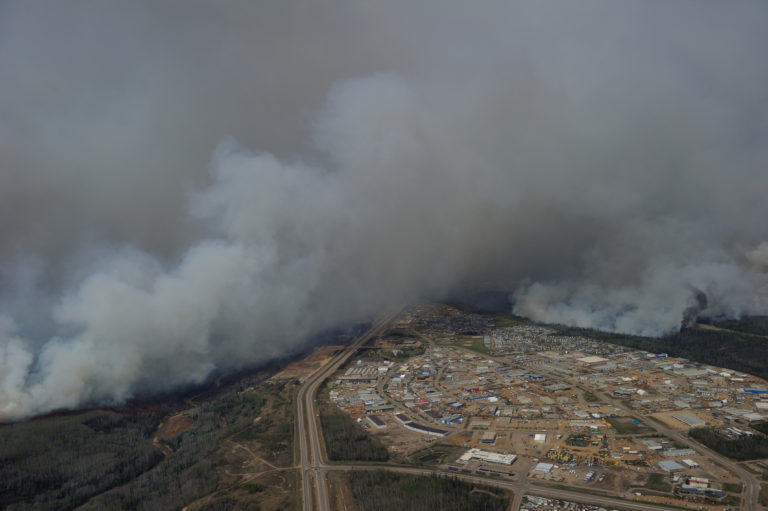
Nearly $3.6 billion in insured losses from Fort McMurray wildfire: CatIQ
July 7, 2016 by Canadian Underwriter
Print this page Share
Insured damage from the recent wildfire affecting Fort McMurray, Alta. is estimated at $3.58 billion, Insurance Bureau of Canada’s vice president western and Pacific, Bill Adams, said Thursday.
A third of the $3.58 billion loss is commercial property, 5% is auto and 62% is personal property, said Carolyn Rennie, managing director at Toronto-based Catastrophe Indices and Quantification Inc. Rennie and Adams made their comments during a media teleconference.
The wildfire that started in early May resulted in the evacuation of about 80,000. The disaster was “by far the largest insured natural catastrophe in Canadian history,” Adams said.

Aerial view of the wild fires in the Fort McMurray area on May 4, 2016. Photo by MCpl VanPutten, Canadian Forces
“Business interruption is taken into account,” Rennie said. “It’s part of the entire commercial claim. We don’t break out the business interruption at this point but CatIQ will be releasing that to individual subscribers on the next estimate.”
Further breakouts are available to CatIQ subscribers, Rennie noted.
Rennie said there were about 27,000 personal lines claims averaging $81,000 each, about 5,000 commercial claims averaging “close to” $250,000 each and about 12,000 auto claims averaging about $15,000 each.
CatIQ – a sister company to MSA Research Inc. – works with insurers to aggregate industry losses. When measured by direct premiums written, about 80% of the market participates with CatIQ, Rennie said, adding the firm grosses its estimates up to account for 100% of the industry.
Its estimates exclude loss adjustment expenses and take into account losses before reinsurance.
Heather Mack, IBC’s director of government relations, suggested Thursday there are “no real concerns at this point” about reinsurance rates in the aftermath of Fort McMurray.

Bill Adams, vice president western and Pacific, Insurance Bureau of Canada
“If you look at the Alberta based insurers, certainly they have got to be looking at their risk exposure because obviously Alberta is so prone to some of these natural catastrophes over the last 20 years, but we haven’t heard anything directly from those companies about either pricing or availability on the reinsurance market,” Mack said.
The natural disaster with the second-highest insured loss – at $1.7 billion – was the flooding affecting southern Alberta in the summer of 2013, Adams said, adding those floods caused about $6 billion in total economic losses. Most of the $1.7 billion in insured losses were from sewer backup. At the time, overland flood coverage was generally not available on homeowners’ insurance policies in Canada.
Before the summer of 2013, Canada’s three costliest natural disasters, when measured by insured losses, were the ice storm in Ontario and Quebec in 1998 ($1.295 billion), the fire in Slave Lake, Alta. in 2011 ($700 million) and a storm in Toronto in August, 2005 ($590 million), Property and Casualty Insurance Compensation Corp. said in an earlier report.
Then in 2013, the Alberta floods took top spot and the July 8 rain storm in the Toronto area (with insured losses of nearly $1 billion) took third spot.
“The vast majority of the ultimate costs” of the wildfire affecting Fort McMurray “will be borne by insurance policies of one variety or another,” Adams said Thursday. “Fire losses are a standard part of the home insurance policy. It was the genesis, historically of a home insurance policy so it would be would be exceptional if not completely unprecedented for there not to be fire coverage in a home insurance policy so anyone who has damage to their homes who has insurance, their insurance policy will respond according to the conditions of that particular policy.”
IBC does not have an estimate yet of uninsured damage.
“We are doing an assessment and comparing an aggregated civic address list generated by the regional municipality (of Wood Buffalo) of all demolished structures and we are aggregating from the insurance industry a list of insured properties,” Adams said. “When we compare the two, obviously there will be a gap. We anticipate that that would give us the best estimate of the total number of uninsured properties in the regional municipality but that work has not been completed yet.”
Online Editor’s note: A previous version of this story incorrectly quoted Carolyn Rennie as saying there were “no real concerns at this point” with reinsurance.
Roundup of Canadian Underwriter's Daily News items on the #FortMcMurray #wilfire: https://t.co/t6Dvr0x3vS #ymmfire pic.twitter.com/vVtxC9Qnw1
— Canadian Underwriter (@CdnUnderwriter) June 10, 2016
Have your say: